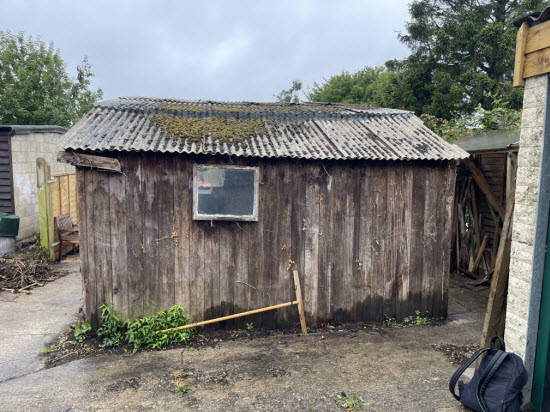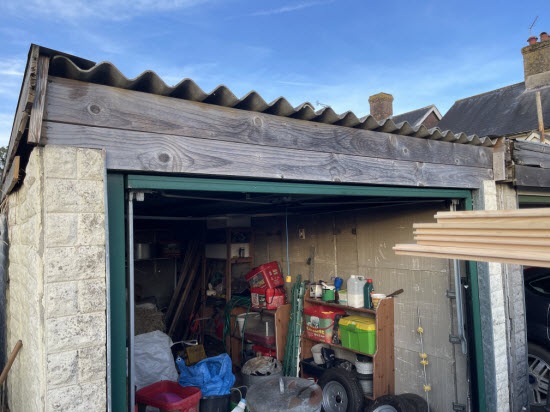Asbestos Shed Roof: A Hidden Risk or a Harmless Relic?
Why it's worth knowing what your roof is made of-especially before any repair work begins
Last spring, I got a call from a lady near Hawkhurst in Kent who needed help with two buildings on her property: a timber garden shed and a detached garage. Both had corrugated fibre cement roofs, and both were in need of attention.
 This was the shed that was going to demolished and removed
This was the shed that was going to demolished and removed
The garage needed repairs around the roof structure. The shed, on the other hand, was beyond saving-it needed to come down completely. But before we so much as lifted a hammer, there was one critical question we had to answer:
Did either of these roofs contain asbestos?
They looked similar-both old, grey, and wavy in that familiar corrugated pattern. But only one turned out to be a health hazard.
 This was the garage that needed repair work
This was the garage that needed repair work
One Roof Was Dangerous-But You'd Never Know for sure by Looking
The shed and the garage had different styles of fibre cement sheets: the garage used a wider corrugated profile, while the shed had smaller, more tightly spaced corrugations. Both types were commonly used over the last few decades. But asbestos wasn't always easy to spot-and sometimes it wasn't there at all.
To find out, we ordered asbestos test kits from a certified laboratory. These kits allow you to safely take a small sample-about the size of a coin-and send it off for analysis. We took one sample from each roof, sealed and labelled them properly, and posted them off.
A few days later, the results were in. The garage roof was clear. The shed roof wasn't.
That simple test changed everything about how we approached the project.
The Big Misconception: 'If It's Fibre Cement, It Must Be Asbestos'
Here's a common belief we hear all the time:
'If it's grey, corrugated, and cement-based, it must contain asbestos.'
That might have been true decades ago. In the mid-20th century, asbestos fibres were widely used in cement products because they were cheap, fire-resistant, and made the sheets stronger.
But by the 1980s and 1990s, the dangers of asbestos became well known. As manufacturers phased out asbestos, they replaced it with cellulose fibres-essentially treated paper pulp. From the outside, these modern sheets look almost identical to older ones.
So the truth is: some fibre cement roofs contain asbestos, and some don't. The only way to be sure is to test.
Is an Asbestos Shed Roof Always a Risk?
Not unless it's disturbed-but if you're planning work, you need to know.
Asbestos cement roofing isn't dangerous if it's in good condition and left undisturbed. The cement binds the fibres, preventing them from becoming airborne. So if your old shed roof is intact and you're not doing anything to it, it's often safer to leave it in place and monitor its condition.
But in our case, we were planning roof repair work on the garage and a full dismantling of the shed, including its asbestos roof. This meant the potential for cutting, breaking, or damaging the cement sheets-which could release fibres into the air.
That's when asbestos becomes dangerous-and why we needed to know exactly what we were dealing with before any work started.
Safe Handling: What You Can (and Can’t) Do Yourself
Here's what we did:
- The garage roof, having tested negative for asbestos, was repaired with standard precautions.
- The shed, which did contain asbestos, was in poor condition. We brought in a licensed asbestos contractor to dismantle and dispose of the roof properly.
If the shed had been in better condition, we could have done it ourselves-legally and safely-with the right protective measures.
If you're removing an asbestos shed roof yourself, here's what's required:
- Wear disposable overalls and an FFP3-grade respirator
- Dampen the sheets to minimise dust
- Keep sheets intact-avoid breakage
- Double bag in heavy-duty polythene
- Transport to a licensed asbestos disposal site (by appointment in many cases)
How Much Does Asbestos Testing Cost?
The test kits we used cost around £30-£50 per sample. They come with instructions and protective gear, and offer the peace of mind of knowing what you're dealing with.
Considering the potential health risks and legal responsibilities, it's a worthwhile investment.
Conclusion: Don't Guess-Test
If you've got an older shed roof and you're planning to repair, replace, or dismantle it, don't assume and don't take risks. Just because a roof looks like asbestos doesn't mean it is. And just because it doesn't look dangerous doesn't mean it's safe to disturb.
A simple asbestos test lets you plan confidently, take the right precautions, and avoid unnecessary expense-or exposure.
Key Points Recap:
- Not all corrugated fibre cement sheets contain asbestos
- Asbestos cement roofs are safe if left undisturbed
- Testing is affordable and simple
- DIY removal is possible with proper PPE and care
- Use licensed contractors for damaged or high-risk roofs

Keep in touch with our monthly newsletter
Shed Building Monthly




